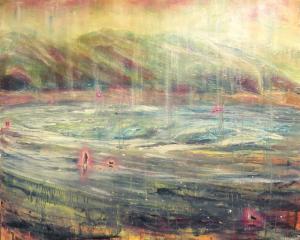"Deluge", Lorraine Rastorfer (Milford Galleries Dunedin)
Lorraine Rastorfer produces this feeling through abstract canvases using the unusual medium of pearlescent paint. Rastorfer has created patterns by randomly placing seeds, then allowing thin washes of paint to flow over and around them.
The long, streaked shadowy regions created are reminiscent of sharply side-lit Nasa images of alien worlds, or of channels left in sand by the outgoing tide.
The seeds, once removed, leave an unsettling null space which our minds seek to fill or explain. Space is important to the works, and the artist's interest in oriental art leads to the use of large open areas which allow the eye to wander across the canvas.
Like vertical Zen gardens, the pictures allow the mind to focus on individual details and to create new journeys through the art's world with every new view.
The impression is of art which, at first glance, seems minimal, but which gains new facets with repeated viewing. This aspect is compounded by the multi-hued reflections which the art gains from the medium.
With every slight shift of the light source or the viewer, new swirling patterns of soft colour emerge from the surface of the works, creating a most pleasing result.
"Hen's Teeth", Joanna Braithwaite (Milford Galleries Dunedin)
• Joanna Braithwaite provides a subtle air of unease in her works in an entirely different way.
The human element of jewellery breaks the nature study, twisting it into a magic-realist world where the bird is intelligently assessing its viewer, rather than simply staring from the canvas.
The poses are reminiscent of formal portraits. The mind is drawn to Baroque court paintings, and yet it is a king shag, not a human king, which greets the eye.
As pure nature studies, the works are beautifully crafted with strong attention to detail, and well-capture the life behind the eyes which can make or break a bird painting.
The simple addition of pendants and collars raises the works to a new level, and provides extra layers of meaning, again, similarly to the use of props in traditional portrait painting. Occasionally, the meaning is clear, or is explained by the work's title.
In other pieces, the meaning is hidden, and it is up to the viewers to create their own interpretations.
"Fabrication", Sandra Thomson (Monumental Gallery)
• Sandra Thomson's exhibition at Monumental is the first in a series of exhibitions by Christchurch artists, Monumental having thrown open its doors to artists hit by the recent disaster in that city.
The bags, collars, and cloth are attractive but angry. They take as their theme the misuse of religion by zealots, as a tool for the denial of science and as a trigger for war.
Each work carries a strong message, but steers clear of becoming blatant diatribe, instead using its elements wisely to produce art which is attractive in its own right even when the message is not taken into consideration.
Recurring motifs include the DNA double helix, which in one of the large pieces cleverly becomes a neck-ribbon upon which anthropological family portraits are strung. Apes and prehistoric creatures are also represented in the "religion versus science" works, whereas weapons of war make repeated appearances in the "fighting for faith" images.
The most chilling of these shows two disembodied gas masks under bishops' mitres against a background of falling bombs.









![... we all become all of these things [installation view] (2025), by Megan Brady.](https://www.odt.co.nz/sites/default/files/styles/odt_landscape_small_related_stories/public/story/2025/03/1_we_all_become_all_of_thes.jpg?itok=SH-Q8KJZ)


![Poipoia te Kākano [installation view]. Allison Beck, Megan Brady, Kate Stevens West, Jess...](https://www.odt.co.nz/sites/default/files/styles/odt_landscape_small_related_stories/public/story/2025/02/1_poipoia_te_k_kano.jpg?itok=_BEDlada)